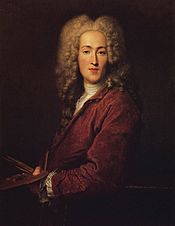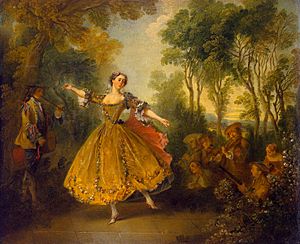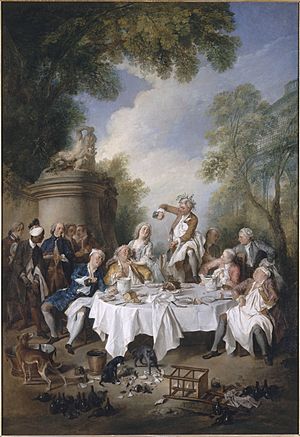Nicolas Lancret facts for kids
Quick facts for kids
Nicolas Lancret
|
|
|---|---|

Lancret (self-portrait)
|
|
| Born | 22 January 1690 Paris, France
|
| Died | 14 September 1743 Paris, France
|
| Nationality | French |
| Known for | Painting |
Nicolas Lancret was a French painter born in Paris on January 22, 1690. He was known for his lively paintings that showed the fun and fashion of French society. He painted during the time when the Duke of Orleans was in charge, and later, when King Louis XV began his rule. Lancret died on September 14, 1743.
Contents
Lancret's Artistic Journey
Nicolas Lancret first studied painting with Pierre d'Ulin. However, he really looked up to another painter named Antoine Watteau. Because of this, Lancret left Ulin to study with Claude Gillot, who had also taught Watteau. Lancret was Gillot's student from 1712 to 1713. Gillot had a big impact on Lancret's early paintings. You can see Gillot's style of painting thin figures in many of Lancret's younger works.
Lancret painted two pictures that were shown in Place Dauphine in Paris. These paintings were a huge hit! They helped him become famous and successful. Some people even thought Watteau had painted them. This success, it is said, made Watteau a bit distant from Lancret.
In 1718, Lancret was accepted into the Royal Academy of Painting and Sculpture. This made him a very respected artist, especially among those who admired Watteau's work. He even created paintings to decorate the famous Palace of Versailles. His art style also became popular with Frederick the Great, a powerful king. Lancret's growing fame led to him becoming a councillor at the Academy in 1735.

Lancret's Art Style and Famous Works
Lancret created many paintings, and more than eighty of them were later made into engravings. An engraving is a print made from a design cut into a surface. While he did paint some portraits and historical scenes, he mostly loved to paint everyday life. His favorite subjects were balls, fairs, and village weddings. This focus on fun, lighthearted scenes was typical of the Rococo art style.
Some art experts believe Lancret's work is not as amazing as Watteau's. They often say his drawing and painting style is clever but a bit plain. Art historian Michael Levey once said Lancret was "no poet but a charming essayist." This means his art was pleasant and well-done, but perhaps not deeply emotional. Lancret's precise style might be because he trained for a while under an engraver.
Many people think Lancret's best paintings were made later in his life. These works show that he became better at making art and nature blend together. His figures also became a bit fuller and looked more solid in his paintings. These changes showed the influence of Watteau's later works, like L'Enseigne de Gersaint.
Lancret's very last painting, Family in a Garden, is now in The National Gallery in London. Michael Levey considers it his "masterpiece." The painting shows a family enjoying coffee together. It feels very personal and has a touch of humor. The painting's smooth lines, soft pastel colors, and charming subject (a wide-eyed young girl trying coffee for the first time) show a delicate sense of life and freshness. This style even reminds some of the future works of Thomas Gainsborough and Jean-Honoré Fragonard.
The British Museum has a wonderful collection of Lancret's studies drawn with red chalk. The National Gallery, London, also has four of his paintings. These include the "Four Ages of Man," which show different stages of life.
Lancret's Personal Life
Nicolas Lancret remained single for most of his life. However, in 1741, he married an 18-year-old girl. She was the granddaughter of Edmé Boursault, a writer. The story goes that Lancret decided to marry her after finding her and her very ill mother living in poverty. He heard that the daughter might soon have to go to a convent. Lancret died from pneumonia on September 14, 1743.
Gallery
See also
 In Spanish: Nicolas Lancret para niños
In Spanish: Nicolas Lancret para niños





